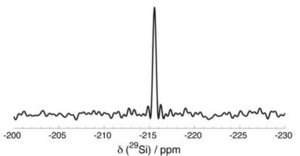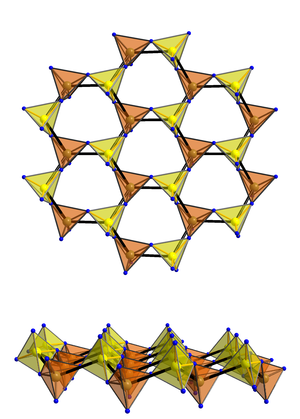In this project synthetic routes to a so far scarcely investigated class of non-metal oxo-anionic compounds are developed. In the course of our investigations we were able to show that by reactions with highly concentrated mineral acids under harsh conditions compounds with unprecedented properties may be obtained. A fine example is the novel tris-(disulfato)-silicate anion [Si(S2O7)3]2- (Fig. 1, top), which showed octahedral silicon coordination by three inorganic ligands for the first time. This leads to a very large chemical shift in the solid state NMR spectrum (Fig. 1, bottom).

A further concise example is the novel boron sulfate B2S2O9, which could be obtained via hydrolysis of HSO3Cl with B(OH)3. In this compound the [BO4]- and [SO4]- tetrahedra are linked to a double layer, analogous to the topology of well known phyllosilicates (Fig. 2). In contrast to the respective silicate compounds these layers are not charged. The electric neutrality may offer interesting properties of such type of compounds. Analogously to Phyllosilicates, which are important materials in consequence of their manifold intercalation probabilities, B2S2O9 should also be able to host guest compounds in between the double layers. Due to the electric neutrality it should be possible to intercalate also neutral and non polar molecules.
Further actual research in the field of non metals point at the synthesis of Phosphorus compounds. Following our hitherto knowledge of the elements Silicon and Boron the generation of phosphorus sulfates with widespread tetrahedral networks should be possible, as well as the synthesis of a "disulfato phosphate" with octahedral Phosphor coordination which is completely unknown up to now.


Abb. 1 Das tris-(disulfato)-silicat Anion [Si(S2O7)3]2- (oben) und das 29Si MAS-NMR-Spektrum von (NH4)2[Si(S2O7)3] (unten)
Ein weiteres prägnantes Beispiel ist das neuartige Borsulfat B2S2O9, welches durch Hydrolyse von HSO3Cl mit B(OH)3 erhalten wurde. In dieser Verbindung werden [BO4]- und [SO4]-Tetraeder zu einer Doppelschicht verknüpft, deren Topologie jener bekannter Schichtsilicate entspricht (Abb. 2). Diese Schichten sind jedoch im Gegensatz zu den Silicaten ungeladen. Hieraus könnten sich interessante Eigenschaften derartiger Verbindungen ergeben. In Analogie zu den Schichtsilicaten, die durch ihre mannigfaltige Intercalierbarkeit bedeutende Materialien für verschiedene Anwendungen sind, sollte auch B2S2O9 Gastverbindungen zwischen den Doppelschichten aufnehmen können. Durch die Elektroneutralität der Schichten sollten hierbei sogar neutrale und unpolare Moleküle intercaliert werden können.
Weitere aktuelle Forschungen auf dem Gebiet der Nichtmetalle zielen auf die Synthese von Phosphorverbindungen ab. Nach unseren bisherigen Kenntnissen für die Elemente Silicium und Bor erscheint die Bildung von Phosphorsulfaten mit ausgedehnten Tetraedernetzwerken ebenso möglich wie die Bildung eine „Disulfato-Phosphats“ mit oktaedrischer Phosphor-Koordination, die bisher unbekannt ist.

Abb. 2 Schichtsilicat-artige Struktur von B2S2O9